Time Audit: What It is and How to Do It? [With Examples]

Main Takeaways
-
See where your time goes, stop bad habits, and focus on what matters most to reach your goals.
-
Use a simple plan to check, change, and improve how you spend your day for better results.
-
Get smart tips to make your time checks better and keep your days running smoothly.
Trying to figure out where exactly all your time goes? Why does it always feel like there has never been enough time for your work?
A time audit is the solution you need!
I remember feeling the same—looking for effective ways to solve my time management issue. Believe me, time audits are the ultimate productivity strategy that can work for anyone.
However, what’s this time audit, or how do you even do it? I’ll get into its nitty-gritty, including:
So, keep reading!
What is A Time Audit?
A time audit is a method of tracking how you spend your time on work-related activities in a day, week, or month. It helps you gather information on where your time goes, what you should prioritize, and where you waste it.
Moreover, it reveals habits and patterns that often go unnoticed. Thus you can identify areas for improvement and better time utilization. It assists you in making more intentional choices with your time and enhances productivity.
Why Conducting A Time Audit is Important?
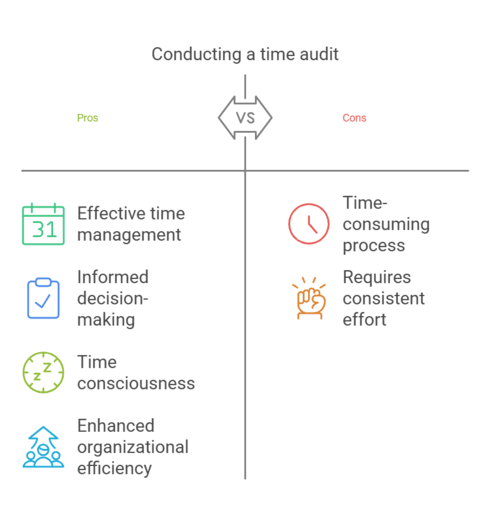
Unfortunately enough, a survey says nearly 49% of people never conduct a time audit and miss the opportunity to improve their time management.
“If you don’t know where the time is going, how can you know if you’re changing the right things?”
-Laura Vanderkam,
Author, Productivity Expert
However, conducting a time audit can optimize your productivity and efficiency. Here let’s take a look at time audit benefits.
Effective Time Management
In the past, I felt stuck between the workload of my both personal and professional life. During that hard time, time auditing really helped me out.
How? Simple explanation!
Time audits help to identify unproductive activities and areas for improvement. Ultimately, you can make the most of each day and enjoy the time management benefits.
Make a Well-informed Decision
Note that you are likely to achieve your goals faster when you attach a time audit to them. Even the American Psychological Association research shows that monitoring your progress increases the chance of succeeding in your goals.
It provides you with a complete insight into your daily activities. As a result, you can make an informed decision about how you can prioritize your work and projects.
Moreover, you can make more strategic decisions that align with your goals. Also, it allows you to spend your time towards your motives and intentions.
Consciousness of Time
Sometimes, we don’t even realize how we’re spending time on useless activities. At the end of the day, we may have spent our hours but may not have results.
In my view, nothing can beat time audit in this case. With an effective time audit, you become more aware of every minute of your day.
It helps you to identify the biggest time wasters in your daily schedule. Thus time audit creates a sense of time consciousness. Moreover, it helps you to make more intentional decisions.
Ultimately leading you the way to make every second productive.
Enhance Organizational Efficiency
Time audit plays a key role in your professional life as well, not just in your personal life. It helps to enhance organizational efficiency, project management, and overall productivity.
With the help of the time audit, you and your employee can identify time-consuming as well as high-priority tasks and work accordingly.
Further Read:
13 Most Effective Tips to Stay Organized at Work
How to Do A Time Audit Effectively Within 5 Steps
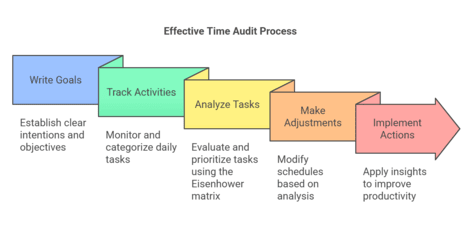
Follow up on the steps and increase productivity in the workplace or at home significantly.
Step 1: Start by writing down your intentions and goals
Before starting, first have a clear understanding of what you really want to achieve with your time audit. It can be that you want to increase your productivity or have more personal activities in your daily routine.
Think about that and clear your motives.
Then start by writing down your goals and how much time you want to spend on each important activity. Your clear intention will guide you to an effective audit process and success.
Research shows that the person writing down their goals has 42% more chance to achieve them than those who don’t.
Step 2: Now track your daily activities
Now that you have a clear understanding of your goal for the time audit, track your daily activities. Identify where and how you are spending your time. Choose a period for your time audit.
Basically, if you have the same work every day, you may not need to record your work daily.
I recommend a weekly timeframe. It’s a good starting point for having a comprehensive view of my daily routine, but you can choose whatever you prefer.
In that chosen period, now you have to record all your activities. Categorize your tasks from the moment you wake up from bed to the moment you go to bed.
For example, check out the table below as an audit timesheet.
Checking emails: 1 hour
Workout: 1 hour
Social media: 1 hour
However, no matter how sharp the memory is, it’ll be hard to keep track of your hours. That’s why I generally use time-tracking tools like Apploye to track my activities effectively.
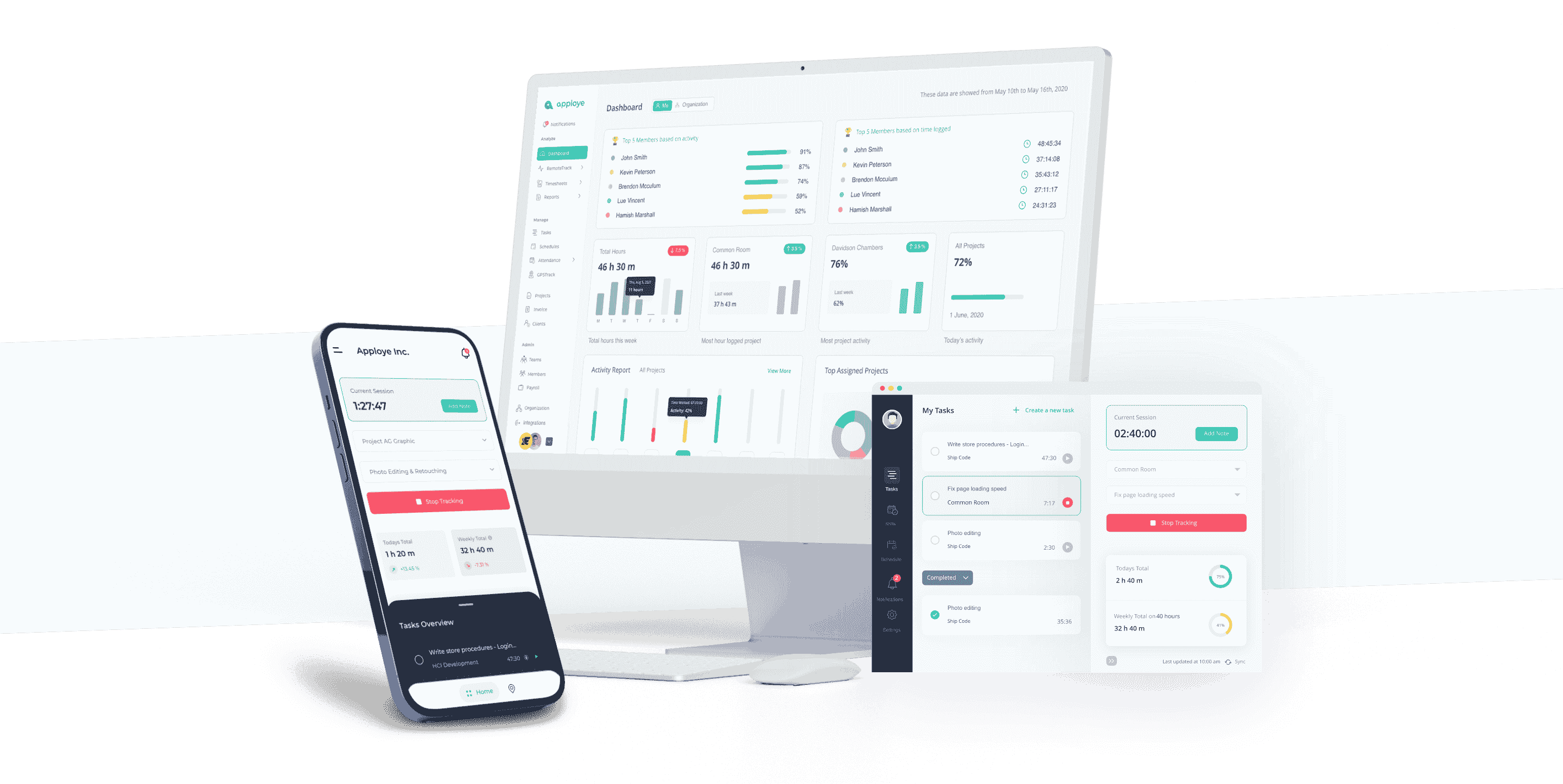
Get Started with Apploye to Track Your Time!
Step 3: Analyze and prioritize the works
With the track of your daily activities in front of you, go through and review all of them. Find out your high-priority work.
For instance, for a blog writer, writing will be his priority and maybe 50% of his time. But for someone, such as a housekeeper, going to market may count as a priority.
However, once you find your high-priority and less-priority tasks, categorize them. Here, the Eisenhower matrix can be incredibly useful. The technique is proven to be the best time management system and 100% to be a workout.
In this technique, you need to divide all your activities into four categories.
- Do First: Name the first category as ‘Do First’. This section will contain all the important tasks of your day. You need to address this as soon as possible.
- Schedule: Name the second category as ‘Schedule’. Its tasks will be important but less urgent. So schedule those tasks to do later.
- Delegate: The third category of tasks will be urgent but less important. You may need to complete the task urgently. However, it will be better to focus on the important, urgent work first.
- Delete: The last category, label it as ‘Don’t do’. Well, that is because these tasks are not important or urgent. That’s why don’t do these tasks at all!
Further Read:
Complete Process of Designing Standard Schedule
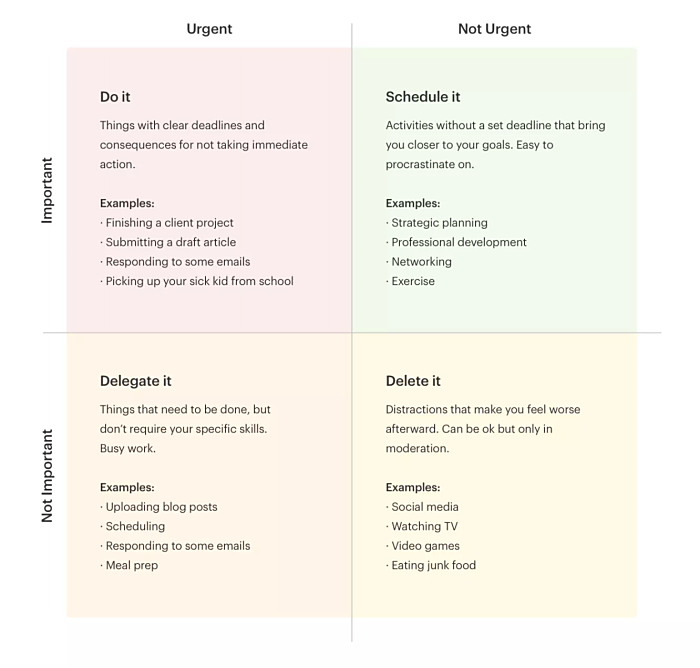
Step 4: Make the necessary adjustments
You now have all the important insights of your time audit worksheets. It’s time to make the necessary adjustments.
Do so based on your analysis. It can ensure you are using your time more effectively.
For instance,
- You can eliminate or reduce your time-wasting activities
- Move some tasks from your responsibility either by delegating or deleting
- Schedule your high-priority work to your most productive time
You can also make a new schedule based on the adjustments you have made.
Step 5: Turn your insight to action
“The key is not to prioritize what's on your schedule but to schedule your priorities.”
Stephen CoveyI
Even after conducting the most effective time audit, it will not do you anything until you turn your insights into action.
If you notice that you are starting your work early in the morning and working till late but not achieving goals, there must be something you miss out.
You may need to work more efficiently or reanalyze your time audit. Moreover, if you are easily distracted, find out the problem and try to address it.
Common Mistakes in Time Auditing and How to Avoid Them
I can say that doing a time audit was really helpful in enhancing my productivity and efficiency in my work. However, ignoring some things can lower its effectiveness. Below are the common mistakes I have faced and dealt with them.
Not to track every activity
At first, I used to track only my main tasks. I thought that it would be helpful to make the time audit effective. But truly that’s not the case.
Your every activity in a day matters in time auditing. If you don’t track even your small activity, you’ll never be able to identify your time wasters.
The main motive of a time audit is to analyze how you spend your time in a specific period. So, if you leave out parts of your daily activity for a day, it’ll be nearly impossible for you to use your time effectively.
Not to categorize each activity
Your time audit should show your priority tasks, with more time for more important ones. You can do so only when you have a clear concept about your most priority and least priority tasks.
But mis-categorizing your daily work fails to achieve the ultimate goal of time audit. This mistake can decrease your productivity.
Moreover, you may be spending more time on tasks that don’t even matter that much.
Use Apploye to Break Tasks and Track Them
Ignoring small time-wasting activities
You should never ignore small time wasters for an effective time audit. I know that small-time waste may seem like nothing.
But when they accumulate over a longer period, they can take a notable time of your day.
That’s why you should identify and address them in your time audit.
Best Practices to Improve Time Management After A Time Audit
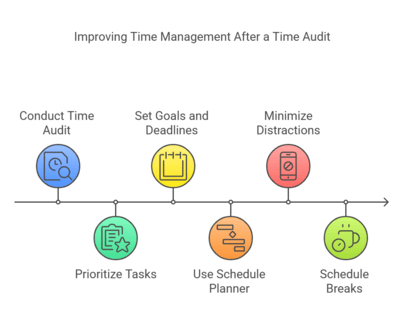
Now that you’ve done a time audit, what’s the next? After a time audit, it needs clear strategies to improve time management.
You can utilize these:
- Follow the insights of your audit time and prioritize the work accordingly. Aim to complete high-priority tasks first.
- Set specific goals and deadlines for your every task. Make the steps of the work manageable to complete it in the set audit time frame.
- Use a schedule planner to plan your whole day. Always review your time management strategies.
- Know your work distractions mentioned in the time audit and take steps to minimize them. Such as you can silence your phone to stay focused.
- Always add breaks throughout the day. A little refreshment helps you to maintain your focus.
Further Read:
12 Best Time Management Techniques to Improve Productivity
Conclusion
When you want to make an effective time audit, you just need to learn it, know it, and use it. It is very simple but useful to make the most use of your time.
Remember to always be kind to yourself throughout the process. Make necessary changes when it is required. Thus you can ensure the continuous improvement of your time management.
Additionally, the purpose of the time audit is to free up time for the things that you really like. So, never forget to add them up!
Frequently Asked Questions
What’s the way to maintain the accuracy of my time audit?
You should record your activities of the day to maintain the accuracy of the time audit. Moreover, you should be honest about it. Use comprehensive descriptions to track your spending time.
How often should you do a time audit?
It depends on your personal choice and needs. You can conduct your time audit for one day. Moreover, it can be for three days, for a week, or even for a month. Your aim should be to get accurate data on how you spend your time.
How frequent should be the reminder of the time audit?
You can choose the interval of the reminder whatever you prefer. Just keep in mind that too many reminders can make you ignore them. That’s why you should adjust the reminder wisely.

